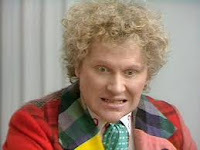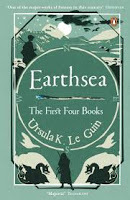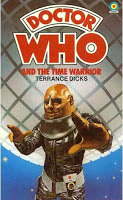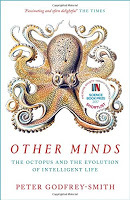Simon Guerrier's Blog, page 48
November 14, 2019
In The Atlantic
 Helen Lewis has written a very good overview in The Atlantic of Samira Ahmed's case against the BBC over pay discrimination. It includes a few words from me.
Helen Lewis has written a very good overview in The Atlantic of Samira Ahmed's case against the BBC over pay discrimination. It includes a few words from me.Picture by Aaron Chown / PA Wire / PA Images - ref: 47995752
Published on November 14, 2019 01:46
November 13, 2019
Doctor Who Magazine 545
 Out tomorrow, the new issue of Doctor Who Magazine names the writers and directors of next year's TV series, and details the results of a Twitter poll on the greatest Dalek stories ever. And that's just the start of the splendid things.
Out tomorrow, the new issue of Doctor Who Magazine names the writers and directors of next year's TV series, and details the results of a Twitter poll on the greatest Dalek stories ever. And that's just the start of the splendid things.At the back, I've reviewed Christopher Eccleston's autobiography, I Love the Bones of You: My Father and the Making of Me (which I read in September). There's also a nice review by Alex Romeo of The Target Storybook - apparently, in my story, first-person narrative is used "to great effect."
Published on November 13, 2019 07:01
November 11, 2019
Galactic Yo-Yo 86
 Episode 86 of the Galactic Yo-Yo podcast features an interview with me talking about writing Doctor Who books and audios, and confessing my love for 1985 story Timelash.
Episode 86 of the Galactic Yo-Yo podcast features an interview with me talking about writing Doctor Who books and audios, and confessing my love for 1985 story Timelash."Simon likes Timelash more than most people do," as Molly says in her introduction. It is true.
Published on November 11, 2019 12:02
November 5, 2019
The Farthest Shore, by Ursula le Guin
 A few months after reading
The Tombs of Atuan
, I'm back in Earthsea for a third instalment. It's been "seventeen years, or eighteen, since the Ring of the King's Rune was returned to the Tower of the Kings in Havnor," at the end of that last book (p. 316). There's a brief reference to what the protagonist of that previous book is up to: having completed her training in magic, she's now, "the White Lady of Gont, Tenar of the Ring" (p. 309). But this is not her story.
A few months after reading
The Tombs of Atuan
, I'm back in Earthsea for a third instalment. It's been "seventeen years, or eighteen, since the Ring of the King's Rune was returned to the Tower of the Kings in Havnor," at the end of that last book (p. 316). There's a brief reference to what the protagonist of that previous book is up to: having completed her training in magic, she's now, "the White Lady of Gont, Tenar of the Ring" (p. 309). But this is not her story.A strange despair hangs over the islands, people losing their sense of magic and even of their own names. Ged, hero of the last two books, is now a distinguished old archmage who teams up with young prince Arren to venture out to the very edge of the world to confront an evil power hoovering up the sparkle of everyone else.
Told from Arren's perspective, this is a more conventional hero quest than the previous instalments, though for all Arren has a special sword there's little conventional bashing people. The one time he uses his sword to do someone a serious injury, it heals almost instantly - the weapon of no effect. Instead, he and Ged travel through a disconcerting wasteland, small communities sickening under the spell. Ged can help one old woman only by making her forget who she once was. Even dragons and Ged's heroes are caught in this fog - rendered unable to speak.
As before, a lot of the book is taken up with the ethics of magic. Arren is not magical but fascinated by the potential of spells, asking about the limits of what can be achieved. Fairly early on, he asks about the power to summon the dead back to life and Ged admits to having known "only one man" work such ancient, seldom-used power:
"He lived in Havnor. They accounted him a mere sorcerer, but in native power he was a great mage. He made money from his art, showing any who paid him whatever spirit they asked to see, dead wife or husband or child, filling his house with unquiet shadows of old centuries, the fair women of the days of the Kings. I saw him summon from the Dry Land my own old master who was Archmage in my youth, Nemmerle, for a trick to entertain the idle. And the great soul came at his call, like a dog to heel. I was angry, and challenged him. I was not Archmage then. I said, 'You compel the dead to come into your house. Will you come with me to theirs?' And I made him come, though he fought me with all his will, and changed his shape, and wept aloud in the darkness." (pp. 368-9)This seemed an important moment in Ged's life and I flipped back through the previous two books to check it wasn't something described there, but it doesn't seem to be. Yet it is significant: the man in question turns out to be the villain of the piece, a wizard called Cob at least equal in power to Ged - if not more so.
Our first sight of Cob himself is a vision on a shore, as Ged explains:
"It was only a sending. A presentment or image of the man. It can speak and hear, but there's no power in it, save what our fear may lend it. Nor is it even true in seeming, unless the sender so wishes." (p. 446)That made me think of Luke in The Last Jedi - though Ged tells us such visions cannot be sent across water. Like that film, victory seems possible not by force of will but the opposite, surrendering the spirit rather than clinging on. Cob is, in many ways, a mirror of Ged in the first book, too eager to dominate, to driven by his own fear. In facing him, Ged shows how far he has come - the farthest shore as much about the extent of his reach as it is the physical place where this occurs.
The result feels like a proper ending to a trilogy, though there's still a book to go in this collection...
Published on November 05, 2019 05:12
November 1, 2019
Standing with Samira
 Around the childcare, the Dr and I had turns this week to stand in solidarity with Samira Ahmed taking the BBC to tribunal over unequal pay. I've been Samira's producer on a number of projects, including four documentaries for BBC Radio 3, and follow the case with close interest.
Around the childcare, the Dr and I had turns this week to stand in solidarity with Samira Ahmed taking the BBC to tribunal over unequal pay. I've been Samira's producer on a number of projects, including four documentaries for BBC Radio 3, and follow the case with close interest.Picture by Aaron Chown / PA Wire / PA Images - ref: 47995752
Published on November 01, 2019 03:46
October 30, 2019
The Time Warrior, by Terrance Dicks
 The death of maestro Terrance Dicks earlier this year prompted me to revisit this novelisation which I so loved as a kid.
The death of maestro Terrance Dicks earlier this year prompted me to revisit this novelisation which I so loved as a kid.The TV story The Time Warrior (1973-74) was the first adventure in Jon Pertwee's final year as the Third Doctor. It introduced new companion Sarah Jane Smith and the monstrous Sontarans - though the Doctor recognises the species so has met them before off-screen. (I wrote an audio story about the Doctor's first encounter with Sontarans.)
Dicks's novelisation was first published in June 1978, by which time the Sontarans had faced the Doctor three times on screen. Dicks had been script editor on the TV version of the story: he commissioned it from Robert Holmes, oversaw the development of the storyline and rewrites on the scripts, and presumably did at least a polish. According to him, it was originally to be novelised by Holmes who only produced the 10-page prologue of the book. This presents a space battle that would have been tricky to realise on screen, and surely owe something to the opening scenes of Star Wars (1977).
The protagonist in this space battle is Jingo Linx, Commander in the Sontaran Space Corps. That first name was in the TV script but never used on screen. We learn a little of the Sontarans: their home planet is Sontara (not Sontar, as in 2008 TV episodes) and they have a "Sontaran Anthem" (which does match 2008). But Holmes tells us little about their perennial enemies the Rutans - though by the time he wrote this prologue they'd been seen on screen, in TV story Horror of Fang Rock (1977) which he had commissioned as script editor from Dicks as writer. It's surprising there's no mention here of jellyfish or shape-changing, or the eerie green glow, that neither Dicks nor Holmes sought to join up those dots.
During the space battle, Linx manages a "fly-pass through the constellation of Sagittarius." As I now know from my GCSE astronomy, a constellation only looks like a group of stars as seen from Earth, and are usually not close to one another at all. Holmes is similarly rough on history: both TV and book versions have peasants peeling potatoes - famously from the New World - in England of the Middle Ages ("the thirteenth century" according to Sarah in 1975's The Sontaran Experiment).
After the prologue, Dicks follows the TV story pretty closely. Linx crashes on Earth and makes an uneasy alliance with local warlord Irongron. When Irongron can't supply suitable nerds to help Linx fix his spaceship, the Sontaran kidnaps them from the 20th century - which gets the attention of the Doctor. Holmes' dialogue is rich and witty, perfectly establishing the characters and their worldview. Dicks' prose is straight-forward, pithily getting on with the story.
Chapter four introduces Sir Edward, Lady Eleanor and their archer Hal earlier than the TV version. Hal and Sir Edward are back from the Crusades, the implication being that Irongron and his men have not and so are sort of draft-dodgers. Lady Eleanor is a stronger character here than on screen, taking a more active role in combatting the wicked Irongron - there's a little of Lady Macbeth when she orders Hal to kill him. That neatly links to the thread of Sarah as the independent, liberated woman out of her time in a man's world.
Sir Edward's page is given a name - Eric - and we see the moment he's captured by Irongron's men, rather than just being told about it. This is Dicks the novelist adding in big action moments he would have cut as script editor. It makes me wonder how much of the screen version was his anyway - he would give writers two or three drafts before taking over their scripts.
The TV version does not give us what now seems like a glaring omission - Sarah's first impression of the TARDIS interior. It's fleeting here, but present all the same on page 53. Dicks says Sarah doesn't have time to "fully take in the wonder of her surroundings", and is more concerned about correcting another issue: how she stows away in the TARDIS without the Doctor seeing her. The simple solution is to have her hide in "a kind of cupboard" - the "kind of" suggesting something a bit more sci-fi than MFI.
Another simple intervention is the explanation of context.
"This was an age in which explosives in any form were still unknown. Bangs and flashes and clouds of stinking smoke could have only one explanation. 'Devil's work,' screamed one of the soldiers." (p. 103)But really, there's little embellishment of events as seen on TV - though at one point there's this incongruous image:
"High on the battlements Sarah was doing a celebratory dance." (p. 104)I liked the joke that when the Doctor and Sarah disguise themselves in cassocks, his is too short and hers too long. Dicks also feels the need to provide a four-and-a-half line section explaining where those robes came from, with Sir Edward having given a "handsome donation" to two monks.
Reading the book again made me aware of something I was less aware of in the TV version: how much back and forth there is between the two castles. The Doctor bests Linx or Irongron, then returns to Sir Edward's castle, only to say he must go back to face Linx and Irongron - several times. In the book, the Doctor also pops back to the TARDIS for supplies before making his stink bombs, and in popping back again to the TARDIS for the silver "umbrella" that he uses in his final battle against Linx, we're told in the book that he changes his shirt and jacket. This all makes the pacing more leisurely, less urgent. On TV, getting the "umbrella" from the TARDIS is just about excusable but making several trips into the ship feels like cheating.
And something else: Linx mocks humanity's "primary and secondary reproductive cycle" and says the Sontaran method is more efficient. But there's no mention of clones, no suggestion that there are millions more of his kind out there, just like him. This is a chance encounter, Linx visiting Earth by mistake because he's so far from his own people.
So many Doctor Who monsters are conceived as potential rivals to the Daleks, ideal for merchandising and sequels. The irony of Linx, the first we see of a multitude of clones, is that he's the perfect one-off.
Published on October 30, 2019 14:14
October 29, 2019
Shirley Jackson in Lancet Psychiatry
 The new issue of medical journal Lancet Psychiatry features my essay, "There's someone in my head but it's not me," on Shirley Jackson's 1954 novel The Bird's Nest. You need to pay to read the full article but here's the opening paragraph:
The new issue of medical journal Lancet Psychiatry features my essay, "There's someone in my head but it's not me," on Shirley Jackson's 1954 novel The Bird's Nest. You need to pay to read the full article but here's the opening paragraph:"When we first meet Elizabeth Richmond in the opening pages of Shirley Jackson's 1954 novel The Bird's Nest, she is 23 and, to her colleagues at the local museum, 'not even interesting enough to distinguish with a nickname'. She has worked for 2 years answering letters from the public, a job that requires 'no very sparkling personality'. She ably, punctually completes the tasks assigned to her but does not seem the kind of protagonist whose ambitions will power a plot. Rather, Elizabeth is someone to whom things happen: and things quickly start to go wrong..." (Simon Guerrier, "There's someone in my head but it's not me," Lancet Psychiatry vol. 6, iss. 11 (1 November 2019), pp. 899-901 - DOI: https://doi.org/10.1016/S2215-0366(19)30411-0)I read a bunch of Shirley Jackson's books last year, and posted some thoughts here:
The Bird's Nest (1954) by Shirley JacksonWe Have Always Lived in the Castle (1962) by Shirley JacksonDark Tales (2016 collection) by Shirley Jackson
Published on October 29, 2019 02:38
October 28, 2019
Radio Free Skaro 712
 Steven Schapansky of Doctor Who podcast Radio Free Skaro interviewed me for episode #712, "Stay on Target". I think that makes me Biggs.
Steven Schapansky of Doctor Who podcast Radio Free Skaro interviewed me for episode #712, "Stay on Target". I think that makes me Biggs.Radio Free Skaro #712: "Stay on Target" with Simon Guerrier
We talk about my contribution to the newly published Doctor Who: The Target Storybook, and about maestro Terrance Dicks, who died in August and whose final contribution to Doctor Who in included in the book. As I say, both I and the Dr rather owe our careers to Terrance.
I think you can probably tell that I'd been at home alone for a few days, the Dr off on half-term excursions with the apes. The bit with me starts at 30:08.
Published on October 28, 2019 03:16
October 24, 2019
Other Minds, by Peter Godfrey-Smith
 Subtitled "The Octopus and the evolution of intelligent life," this is an absorbing mix of marine biology and philosophy, delving into the worldview of the octopus and our sense of what intelligence even is.
Subtitled "The Octopus and the evolution of intelligent life," this is an absorbing mix of marine biology and philosophy, delving into the worldview of the octopus and our sense of what intelligence even is."Cephalopods are an island of mental complexity in the sea of invertebrate animals. Because our most recent common ancestor was so simple and lies so far back, cephalopods are an independent experiment in the evolution of large brains and complex behavior. If we can make contact with cephalopods as sentient beings, it is not because of a shared history, not because of kinship, but because evolution built minds twice over. This is probably the closet we will come to meeting an intelligent alien." (p. 9)I've waded through some of this stuff before - see my published work on the octopus. Godfrey-Smith also uses studies of other species to shed light on octopus intelligence and our assumptions. He discusses the findings of Baboon Metaphysics , which made me wonder how applicable quotations from Jane Austen would be to the octopus.
This all helps place the octopus in context but the most arresting bits of the book are when Godfrey-Smith is in the water with them, reporting directly, and in his logical analysis of how different their biology and therefore their worldview is to ours.
"Some features show a mixture of similarity and difference, convergence and divergence. We have hearts, and so do octopuses. But an octopus has three hearts, not one. Their hearts pump blood that is blue-green, using copper as the oxygen-carrying molecule instead of the iron which makes our blood red. Then, of course, there is the nervous system - large like ours, but built on a different design, with a different set of relationships between body and brain." (p. 74)That nervous system extends into the limbs, effectively meaning that octopuses "see" with their arms to a limited extent, as well as with their eyes. Godfrey-Smith discusses (on p. 80) tactile vision substitution systems (TVSS), where a video camera attached to a blind person converts optical images into vibration or electrical stimulation the person can feel. When a dog walks past, the blind person doesn't feel a vibration so much as sense an object in motion, relative to themselves. Key to this is that the TVSS works in real time, so the person's own position and movement is part of the sensation: you move, and sense how that affects the relative position of objects around you.
We then return to the octopus:
"What could it be like to see with your skin? There could be no focusing of an image. Only general changes and washes of light could be detected. We don't yet know whether the skin's sensing is communicated to the brain, or whether then information remains local. Both possibilities stretch the imagination. If the skin's sensing is carried to the brain, then the animal's visual sensitivity would extend in all directions, beyond where the eyes can reach. If the skin's sensing does not reach the brain, then each arm might see for itself, and keep what it sees to itself." (p. 121)Some of the science is a little hard-going, and (as always) I would prefer footnotes to endnotes, and numbers in the body text to indicate when to check a note. But it's an appealingly short book - 204 pages before the endnotes - stuffed with utterly boggling ideas. It's also an emotional story: the tentative contact with these creatures, the dangers all around them, their shockingly short lives. And then, just when we think we grasp how strange these things are, he undercuts some of what he's said and makes the point that they're not so very distant.
"The mind evolved in the sea. Water made it possible ... When animals did crawl onto dry land, they took the sea with them. All there basic activities of life occur in water-filled cells bounded by membranes, tiny containers whose insides are remnants of the sea. I said in chapter I that meeting an octopus is, in many ways, the closest we're likely to get to meeting an intelligent alien. Yet it's not really an alien; the Earth and its oceans made us both." (p. 200)
Published on October 24, 2019 01:26
October 17, 2019
Doctor Who Magazine 544
 Doctor Who Magazine 544It's 40 years - and six days - since the first issue of Doctor Who Weekly, which is now
Doctor Who Magazine
. Issue 544 celebrates this ridiculous milestone with all sorts of goodies, including - hooray! - and index of features and interviews that is really useful for a job I'm doing today.
Doctor Who Magazine 544It's 40 years - and six days - since the first issue of Doctor Who Weekly, which is now
Doctor Who Magazine
. Issue 544 celebrates this ridiculous milestone with all sorts of goodies, including - hooray! - and index of features and interviews that is really useful for a job I'm doing today.Also in the issue is a short interview with me about my forthcoming Doctor Who audio story, The Home Guard .
Published on October 17, 2019 01:23
Simon Guerrier's Blog
- Simon Guerrier's profile
- 60 followers
Simon Guerrier isn't a Goodreads Author
(yet),
but they
do have a blog,
so here are some recent posts imported from
their feed.



